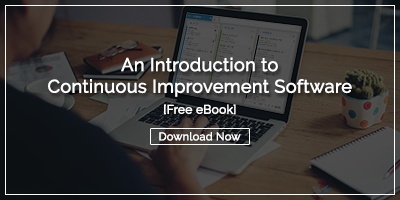 When we chat with people about how their organizations currently manage improvement work, the two most common answers are “We aren’t,” or “Excel.” We’ve written a lot about why it is essential to have some kind of technology to manage improvement projects. Excel might seem like an attractive option for a couple of reasons.
When we chat with people about how their organizations currently manage improvement work, the two most common answers are “We aren’t,” or “Excel.” We’ve written a lot about why it is essential to have some kind of technology to manage improvement projects. Excel might seem like an attractive option for a couple of reasons.
It’s free. Well, not exactly, but chances are everyone already has access to it.
Everyone knows how to use it. Again, not exactly - I mean, no one knows how to use every Excel feature, but people do know how to use it to make lists.
So why not just stick all of your improvement activities in a spreadsheet and track everything that way? The answer is that although it may seem cheap and easy, using Excel for
The Problems with Excel for Improvement Tracking
I’m going
Excel is Passive
Spreadsheets just sit on a PC or online until someone has the thought that
There is No History or Audit Trail
Wondering who changed the deadline in cell D37? With Excel, you are out of luck. There is no audit trail to tell you who did what and when. There is no way to go back and look at what a value was on a certain date.
Versioning is a Nightmare
I can’t tell you how many meetings we’ve seen go off the rails because someone in the room had the wrong version of the spreadsheet. Even if you used a shared drive or host your spreadsheet online, it is impossible to keep people from downloading their own version or emailing it around, creating potentially dozens of copies.
It’s Not Collaborative
"Spreadsheeting" is meant to be a lonely business. Excel was not designed for multiple users. Even online versions, which may allow two people to edit it at the same time, don’t have full collaboration capabilities.
Excel is Not Mobile Friendly
I suppose one can open a spreadsheet on a mobile device, but it simply isn’t a pleasant experience. Be honest, if you find an opportunity for improvement and the only way to report it at that moment is to open up a spreadsheet on your phone and type it in, would you? Me neither.
What These Problems Can Cost You
While it may seem like using Excel is a fiscally responsible approach to improvement management, in the end, it could cost you a lot more than it seems. The costs of spreadsheets add up in terms of:
Ideas that are Never Captured
Maybe you’ll remember to enter that opportunity that you didn’t type into your phone the next time you are in front of a PC, or perhaps you won’t. Teams can’t reap the benefits of implementing employee ideas for improvement if they are never reported. Excel creates unnecessary barriers for users.
Projects that Stall or go Uncompleted
If someone puts a great idea in a spreadsheet, but never acts on it, does it make a sound?
Because Excel is passive, it does not help ensure momentum and does nothing to give management insight into when projects are stalled or when obstacles occur. This leads to slow improvement or sometimes even none at all.
Wasted Time
Every time you have to stop to figure out whether you have the latest version of a spreadsheet or correct someone else who’s used the wrong one, you are losing valuable time that could be used for positive change. Even worse, the frustration of versioning and file management is enough to make some people disengage from improvement work altogether.
Lost Tribal Knowledge
A hodgepodge of spreadsheets is no way to capture all of the lessons learned and best practices that your team uncovers during improvement activities. You can search within a spreadsheet for a certain term, but say you want to know every time that a 5S project was completed across the company if every team has their own spreadsheets, where would you even begin to look?
The Alternative - Improvement Management Software
In the case of improvement work, going with a solution custom built for the purpose will pay off in spades. Look for a solution with:
Active Alerts and Notifications – Keep users informed and engaged by reminding them when key dates are approaching, or a deadline is missed.
Collaboration Capabilities – Allow multiple people to seamlessly work on the same project and capture all communication and related documents.
A Repository of Knowledge – Make it easy to search past improvement work for specific project types, process targets, impact metrics, and more.
A Unified Version of the Truth – Forget about juggling spreadsheet versions. Put all relevant information into one system of record that is updated in real-time and available 24 x 7.
Mobile Application – The best improvement management software includes mobile apps that are easy to use, so you never miss another improvement opportunity.
Customized Dashboards – Leaders and managers have different information needs than team leaders or individual contributors. Your improvement solution should be configurable to meet the needs of every role.
Learn more about the benefits of improvement software over Excel here.
So break out Excel when you need a nice pivot table or have some numbers to crunch, but don’t get sucked down that rabbit hole when it comes to improvement management. Specialized software, designed for the job will give you a substantial ROI and save a lot of headaches.
![[WEBINAR] Bottom-Up Improvement Software Demo](https://no-cache.hubspot.com/cta/default/326641/8545f357-84e1-47b2-81e0-f4fa0d3cd893.png)



Add a Comment